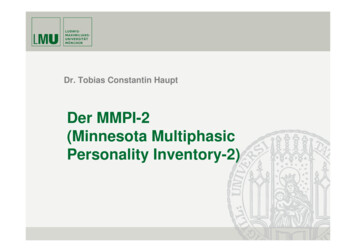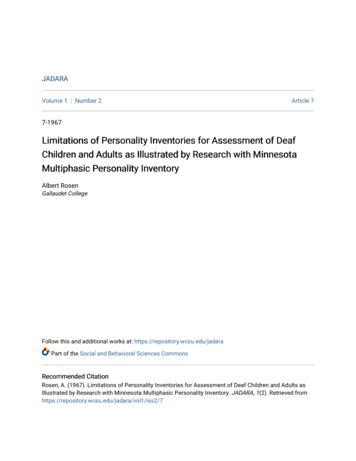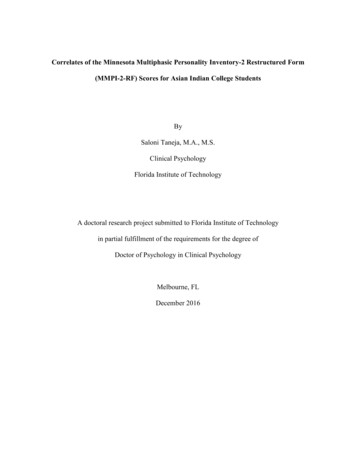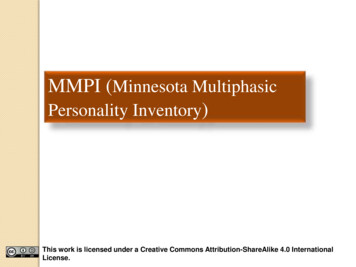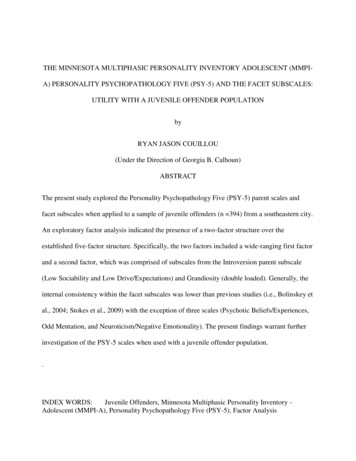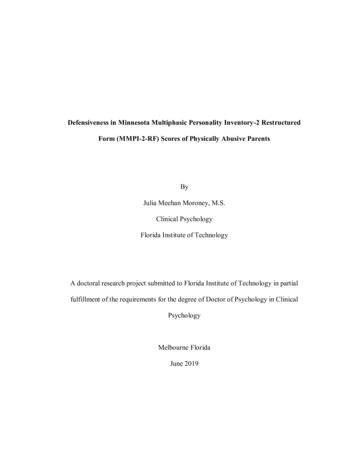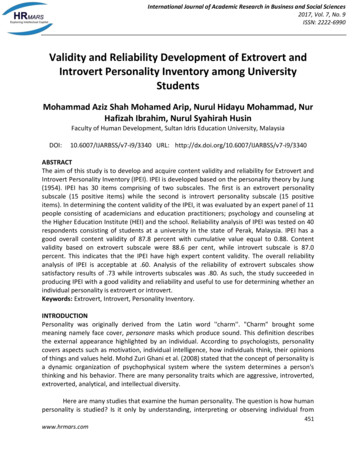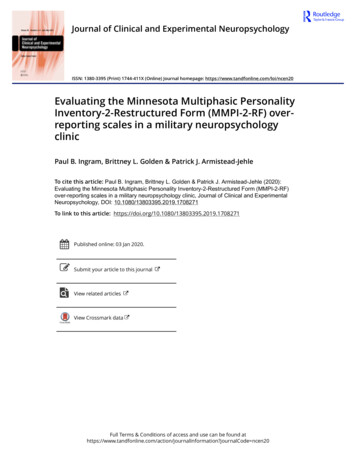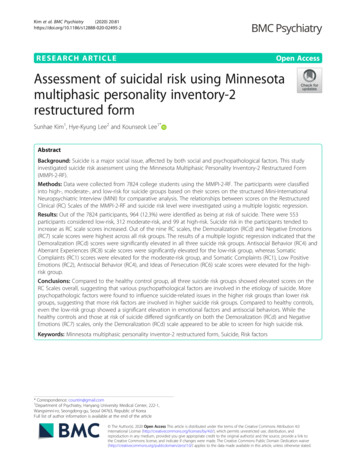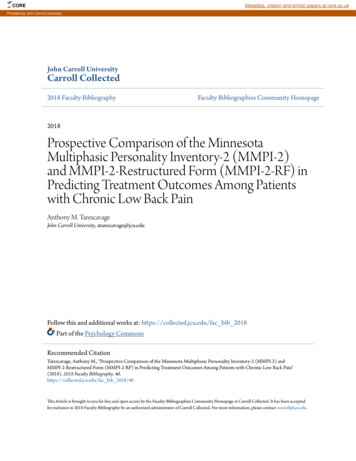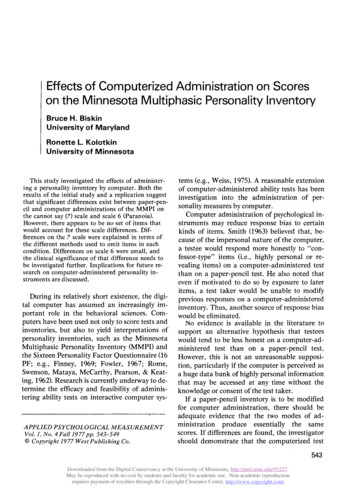
Transcription
Effects of Computerized Administration on Scoreson the Minnesota Multiphasic Personality InventoryBruce H. BiskinUniversity of MarylandRonette L. KolotkinUniversity of MinnesotaThisstudy investigated the effects of administerpersonality inventory by computer. Both theresults of the initial study and a replication suggestthat significant differences exist between paper-pen-ingacil and computer administrations of the MMPI onthe cannot say (?) scale and scale 6 (Paranoia).However, there appears to be no set of items thatwould account for these scale differences. Differences on the ? scale were explained in terms ofthe different methods used to omit items in eachcondition. Differences on scale 6 were small, andthe clinical significance of that difference needs tobe investigated further. Implications for future research on computer-administered personality instruments are discussed.During its relatively short existence,thedigi-tal computer has assumed an increasingly important role in the behavioral sciences. Com-puters have been used not only to score tests andinventories, but also to yield interpretations ofpersonality inventories, such as the MinnesotaMultiphasic Personality Inventory (MMPI) andthe Sixteen Personality Factor Questionnaire (16PF; e.g., Finney, 1969; Fowler, 1967; Rome,Swenson, Mataya, McCarthy, Pearson, & Keating, 1962). Research is currently underway to determine theefficacy and feasibility of administering ability tests on interactive computer sys-(e.g., Weiss, 1975).A reasonable extensioncomputer-administered ability tests has beeninvestigation into the administration of per-temsofsonality measures by computer.Computer administration of psychologicalin-struments may reduce response bias to certainkinds of items. Smith (1963) believed that, beof the impersonal nature of the computer,a testee would respond more honestly to &dquo;confessor-type&dquo; items (i.e., highly personal or recausevealing items) on a computer-administered testthan on a paper-pencil test. He also noted thateven if motivated to do so by exposure to lateritems, a test taker would be unable to modifyprevious responses on a computer-administeredinventory. Thus, another source of response biaswould be eliminated.No evidence is available in the literature tosupport an alternative hypothesis that testeeswould tend to be less honest on a computer-administered test than on a paper-pencil test.However, this is not an unreasonable supposition, particularly if the computer is perceived asa huge data bank of highly personal informationthat may be accessed at any time without theknowledge or consent of the test taker.If a paper-pencil inventory is to be modifiedfor computer administration, there should beadequate evidence that the two modes of administration produce essentially the samescores. If differences are found, the investigatorshould demonstrate that the computerized test543Downloaded from the Digital Conservancy at the University of Minnesota, http://purl.umn.edu/93227.May be reproduced with no cost by students and faculty for academic use. Non-academic reproductionrequires payment of royalties through the Copyright Clearance Center, http://www.copyright.com/
544yields information which is reliable and usefulbeyond that yielded by the paper-pencil form.This question has been addressed by Lushene,O’Neill, and Dunn (1972), who administered theMMPI twice to two groups of female undergraduates in a counterbalanced design. One MMPIwas given in the standard paper-pencil mode,while the otherray tubewasadministeredon acathode-(CRT) computer terminal. Lusheneetal. concluded that the two modes of administration yielded equivalent results on the basic scalesand on a set of MMPI scales developed by Wiggins (1969). Lushene et al. neglected to reportscores on the &dquo;cannot say&dquo; scale (&dquo;?&dquo;). This is animportant omission, since leaving items blankcan reduce scores on one or more scales, possiblyflattening profiles and invalidating the results.The present study was an initial attempt todetermine the feasibility of developing a completely automated assessment program. Com-puter-administered personality tests are beingused in research (Dunn, Lushene, & O’Neill,1971; Lushene et al., 1972) and have alreadybeen incorporated into the admitting system of amental health clinic (Johnson & Williams,1975); however, the equivalence of the computerized forms of these inventories with the paper-pencil forms has not yet been adequatelydemonstrated for various clinical and non-clinical populations. The present studies attemptedto clarify what differences, if any, exist betweencomputerized and paper-pencil forms of theMMPI in a college population. Two experimentsare reported: the first compares scores on computer-administered MMPIs with scores on paper-pencil MMPIs; the second is a partial replication of the first with several proceduralchanges.Experiment 1MethodSubjects.A total of 126 maleundergradintroductory psychology course atthe University of Minnesota participated in thisexperiment.uates in theThree graduate students inasservedthe experimenters.psychologyMaterials and apparatus. The MMPI wasadministered in three modes: (1) in the standardpaper-pencil form, using Hankes answer sheets;(2) by means of a Datapoint 3000 CRT terminalconnected to the University of Minnesota CDC6400 time-shared computer, transmitting dataover phone lines at 30 characters per second(CPS); (3) by means of a teletype (TTY) connected to the same computer, transmitting dataat 10 CPS. All terminals were located in separateair-conditioned rooms to insure privacy. Separate rooms were also used to administer the paper-pencil form of the MMPI. Only the 425items that are scored on the basic MMPI scaleswere administered. In the computer conditions,responses were recorded by pressing &dquo;T&dquo; for atrue response, &dquo;F&dquo; for a false response, and&dquo;?&dquo; for a &dquo;cannot say&dquo; response. Responseswere then transmitted to the computer by havingthe testees press the &dquo;RETURN&dquo; key.Procedure. Students were randomly assigned to one of the experimental conditions. Alltestees were given a brief description of the taskand were read a set of general instructions,which differed slightly between paper-pencil andcomputer conditions. Instructions included information on how to record their responses aswell as assurances regarding the confidentialityof their answers. Students read the instructionsalong with the experimenter. Each experimenteradministered approximately one-third of theMMPIs in each condition. In addition to thegeneral instructions, students in both computerconditions were given some practice with thecomputer by having them record their name,student identification number, and sex in thepresence of the experimenter. In each conditionafter the student understood all of the instructions, the experimenter left the room. Studentsreported to the experimenter upon completingthe task.Analysis. Three types of analyses were employed in order to assess the differences amongpaper-pencil, CRT, and TTY administrations ofthe MMPI. At the profile level, differencesExperimenters.Downloaded from the Digital Conservancy at the University of Minnesota, http://purl.umn.edu/93227.May be reproduced with no cost by students and faculty for academic use. Non-academic reproductionrequires payment of royalties through the Copyright Clearance Center, http://www.copyright.com/
545Table 1Means, Standard Deviations, and Analyses of Varianceof MMPI Scales Administered in Different Formatsamong groups were assessed by means of a multivariate analysis of variance (MANOVA) of rawscale score data. Also computed were the univariate analyses of variance (ANOVA) for eachscale. At the item level, chi-square analyses wereperformed on each item in order to determinedifferences in item endorsements among thethree groups. A comparison of two-point codetype frequencies across groups was also made.Resultsnoia), it is apparent that the F ratio associatedwith the ? scale is so large that it alone could account for the mean profile differences. Examination of the scale means revealed thatthe largest difference among the three groupsoccurred on the ? scale, with each of the computer conditions eliciting an average of about 15non-responses and the paper-pencil conditionaveraging about 2 non-responses. The largestvariability within groups also occurred on the ?scale for the computer conditions.Individual items were compared for differential responseMeans, standard deviations, and the results ofthe MANOVA and ANOVAs are shown in Table 1. The MANOVA revealed significant diferences (p .05)among the mean profiles of thethree groups. When the data were analyzed withthe ? scale excluded, these profile differenceswere no longer found (p .70),suggesting that itwas primarily the ? scale which contributed tothese differences. Inspection of the univariateANOVAs for each scale provided evidence tosupport this. While some of this difference mayhave come from scales 3 (Hysteria) and 6 (Para-patterns using two separate sets ofchi-square analyses (condition x response). Inthe first set, omitted items were coded as missingdata, whereas, in the second set, they were codedas valid responses. Since this study was seen asexploratory in nature, the .10 level was considered satisfactory for statistical significance. Itwas found in the first analysis that 42 itemsshowed significant chi-squares, and in the second analysis that there were 63 significant items.The greater number of significant items whennon-responses were included as valid responsesmay be spuriously high, since many of thoseDownloaded from the Digital Conservancy at the University of Minnesota, http://purl.umn.edu/93227.May be reproduced with no cost by students and faculty for academic use. Non-academic reproductionrequires payment of royalties through the Copyright Clearance Center, http://www.copyright.com/
546items hadexpected frequencies as low as one orconsistently come fromMMPIscales; rather, they disparticulartwo. These items do notanytributeacrossall the scales.Results ofan analysis of two-point codesgroups showed that individuals were distributed across a wide range of profile types bothwithin and between groups; consequently, therewere a large number of code types with very lowor zero frequencies. Thus, given the sample sizeof this experiments, information about frequencyof occurrence of particular codetypes did not appear to be very useful.Because the results of this experiment showedlarge numbers of omitted responses in the computer conditions, a second experiment was designed to determine if: (1) the large number ofomitted responses was due to a mode of administration effect in the computer condition;(2) the number of items omitted was a result ofthe different methods of non-responding (i.e.,leaving an item blank in the paper-pencil condition, as opposed to pressing the ? and RETURNkeys in the computer condition); or (3) the number of items omitted was due to differences indirections given to testees in the computer conditions.acrossExperiment 2MethodSubjects. Thirty-nine male undergraduatesintroductory psychology course at theUniversity of Minnesota took part in the experiin thement.ExpeMmenters. Two trained undergraduatepsychology majors served as the experimenters.Materials and apparatus. Because the TTYcondition took about twice as long to administeras the CRT condition and had no added testingbenefits, only the paper-pencil and CRT conditions were administered. The instructions andanswer sheet in the paper-pencil condition weremodified to allow the testees to respond &dquo;?&dquo; toan item they wished to omit rather than havingthem leave the item blank. The method of responding to omitted items in the CRT conditionalso changed in order to approximate moreclosely the passive method of omitting an item inthe paper-pencil condition (i.e., leaving the itemblank). If respondents wanted to omit an item,they had to press only the RETURN key, ratherthan pressing both the ? and RETURN keys.Directions in the CRT condition were changedto reflect this procedural modification, and alsoto more closely correspond to the standarddirections given in the paper-pencil administration.Procedure. The procedure was essentiallythe same as that in Experiment 1, incorporatingthe changes made in the test formats. In addiwastion,t tests werecomputed comparing means onExperiment 1 and Experipaper-pencil and CRT ad-the ? scale betweenment 2 on both theministrations.ResultsTable 2 contains the means, standard devia-tions, and the results of the MANOVA andANOVAs. Aninspection of Table 2 shows theresignificant mean profile difference bethe modified paper-pencil and computerwas notweenadministrations of the MMPI. In addition, nosignificant difference was found between conditions on the ? scale, with each group omittingabout 11 items on the average. The only scaleshowing a significant difference between conditions was scale 6, which showed higher scores forthe paper-pencil group than the CRT group, justas in Experiment 1.Closer examination of the scale 6 means andstandard deviations in both experiments revealslittle absolute difference between the groups. Asignificant difference was found on the ? scalefor the paper-pencil administrations betweenthe experiments, with a higher mean number ofomitted items [t(64) 3.22, p .01] in Experiment 2. No significant difference was found onthe ? scale for the CRT administrations betweenexperiments [t(53) 1.28, p .101.In the between-group comparison of responses to individual items, 17 items showed significant chi-squares when omitted items were Downloaded from the Digital Conservancy at the University of Minnesota, http://purl.umn.edu/93227.May be reproduced with no cost by students and faculty for academic use. Non-academic reproductionrequires payment of royalties through the Copyright Clearance Center, http://www.copyright.com/
547Tabl.e 2Means, Standard Deviations, and Analyses of Varianceof MMPI Scales Administered in Different Formatsas valid responses. Only one of theseitems (number 302) was an item which produceda significant difference in both experiments;other previously significant items did not repli-treatedcateacrossexperiments.DiscussionIn the present study, significant differencesfound between paper-pencil and computeradministrations of the MMPI on both scale 6and the ? scale. Essentially both types of administrations produced otherwise similar profiles when instructions for both were made nearly equivalent. Differences on scale 6 were small,and the clinical significance of this differenceneeds to be investigated further.The question remains: how can we accountfor differences in the number of omitted itemsbetween modes of administration? Since therewas no significant difference between the meansof the CRT administrations between experiwerements, it can be concluded that the attempt tomake responding to omitted items more passivehad failed. The computer condition, either because of the design of the hardware or becauseof the nature of the software, forced respondentsto make an active response to omit an item;testees had to press the ? key and/or the RETURN key in order for the next item to be presented. On the other hand, in the standard paper-pencil administration testees had to make apassive response to omit an item, i.e., leaving theappropriate space on the answer sheet blank. Itis reasonable to assume that because an activeresponse had to be made in the computer conditions of both experiments, the number ofomitted items would not decrease significantlyfrom the first to the second experiment. In lightof the results of the second experiment, it ap-’pears that differences on the ? scale were notdue to differential reactions to the paper-penciland computer conditions per se, but rather tothe differential response options offered by eachmethod. When the mode of non-response wasDownloaded from the Digital Conservancy at the University of Minnesota, http://purl.umn.edu/93227.May be reproduced with no cost by students and faculty for academic use. Non-academic reproductionrequires payment of royalties through the Copyright Clearance Center, http://www.copyright.com/
548madeactive in the paper-pencil condition(responding ?, rather than leaving the itemblank), the number of non-responses increasedmoresignificantly.Although theredo not appear to be practicaldifferences on overall profiles between the twomodes of administration for most respondents,some way must be found to deal with large numbers of omitted items. Future research might bedirected toward two possible approaches. Aforced-choice format might be used, to eliminateomitted items. Or the computer might check forlarge numbers of omitted items and either inform the tester of this fact, or automatically readminister the entire set of unanswered itemswith instructions to give the best possible response. In addition, researchers might be interested in determining which characteristicsdistinguish those testees who omit many itemsfrom those who omit few items.Another consideration is that of the generalizability of the results of this study. Although the computer-administered MMPIseems to be reasonably equivalent to the conventional paper-pencil administration in a &dquo;normal&dquo; college population, there is no reason toexpect necessarily that these results would generalize to a psychiatric population. For example,it might be reasonable to expect that a paranoidindividual would not react to the computer inthe same way as either a college student or an individual with another psychiatric diagnosis. It ispossible that significant interactions may existbetween person-types and mode of administration. Future research in this area should probably include samples from different psychiatricand nonpsychiatric populations, and should separately examine responses to computer-administered inventories vs. paper-pencil inventories foreach different person-type.Finally, if computerized administration ofpersonality inventories is shown to be appropriate for a variety of sub-populations, the nextgoal should be to investigate the computer’sability to administer a unique subset of items toa testee. Research is already underway on theprinciples of efficiently branching a personthroughanitempoolin theareas(Weiss, 1975; Weissmeasurementof&abilityBetz,1973), personality measurement (Kleinmuntz &McLean, 1968), and diagnostic classification(Biskin, 1975; Butcher, Clavelle, & Hoffman,1974; Morf & Krane, 1973). Although furtherresearch is certainly necessary, preliminary evidence from the present study indicates that theeffects of computer administration on the accuracy of obtained personality inventory scoresmay be minimal, increasing the probability thatbranching models of item presentation can confidently be introduced in the administration ofpersonality inventories.ReferencesBiskin, B. H. The administration of personality testsby computer: some substantive and methodological issues. Unpublished manuscript, University ofMinnesota, 1975.Butcher, J., Clavelle, P., & Hoffman, N. Clinical limitationsof MMPI short forms andastrategy fordeveloping a tailor-made MMPI short form. Paper presented at the 82nd Annual Convention ofthe American Psychological Association, New Orleans, September, 1974.Dunn, T., Lushene, R., & O’Neill, H. The completeautomation of the Minnesota Multiphasic Personality Inventory and a study of its responselatency (Technical Memo No. 28). Tallahassee:Florida State University, Computer-Assisted Instructional Center, 1971.J. C. Manual forFinney,psychiatristsand psy-chologists: psychodiagnostic consultation service,Finney Institute for the Study of Human Behavior.Lexington, Kentucky: Finney Institute for theStudy of Human Behavior, 1969.Fowler, R. Computer interpretation of personalitytests: the automatedpsychologist. Comprehensive6, 455-467.Psychiatry, 1967,Johnson, J., & Williams, T. The use of on-line computer technology in a mental health admitting system. American Psychologist, 1975,30, 388-390.Kleinmuntz, B., & McLean, R. Diagnostic interviewing by digital computer. Behavioral Science, 1968,13, 75-80.Lushene, R., O’Neill, H., &validity ofaDunn, T. Equivalentcompletely computerized MMPI(Technical Memo No. 48). Tallahassee: FloridaStateUniversity, Computer-Assisted InstructionCenter, 1972.Downloaded from the Digital Conservancy at the University of Minnesota, http://purl.umn.edu/93227.May be reproduced with no cost by students and faculty for academic use. Non-academic reproductionrequires payment of royalties through the Copyright Clearance Center, http://www.copyright.com/
549Morf, M., & Krane, W. A strategy for developing automated assessment systems. Behavioral Science,294-306.18,1973,Rome, H., Swenson, W., Mataya, P., McCarthy, C.,Pearson, J., & Keating, R. Symposium on automated techniques in personality assessment. Proceedings of the Mayo Clinic, 1962, 37, 61-82.Smith, R. Examination by computer. BehavioralScience, 1963, 8, 76-79.Weiss, D. J. (Ed.). Computerized adaptive trait measurement : problems and prospects (Research Report 75-5). Minneapolis: University of Minnesota,Department of Psychology, November, 1975.(NTIS No. AD-018675)Weiss, D. J., & Betz, N. E. Ability measurement: conventional or adaptive? (Research Report 73-1).Minneapolis: University of Minnesota, Department of Psychology, 1973. (NTIS No. AD-757788)Wiggins, J.S. Content dimensions of the MMPI. In J.N. Butcher (Ed.), MMPI: research developmentsand clinical applications. New York: McGrawHill, 1969.AcknowledgementsThe authors thankJames Butcher and David Weissfor their support in the early stages of this research.We also appreciate the aid of Gary Kinser in the development of several computer programs. In addition, we acknowledge the help of William Iacono inthe initial phase of the study.Author’s AddressBruce Biskin, Department of Psychology,of Maryland, College Park, MD 20742Downloaded from the Digital Conservancy at the University of Minnesota, http://purl.umn.edu/93227.May be reproduced with no cost by students and faculty for academic use. Non-academic reproductionrequires payment of royalties through the Copyright Clearance Center, http://www.copyright.com/University
543 Effects of Computerized Administration on Scores on the Minnesota Multiphasic Personality Inventory Bruce H. Biskin University of Maryland Ronette L. Kolotkin University of Minnesota This study investigated the effects of administer- ing a personality inventory by computer.Both the results of the initial study and a replication suggest that significant differences exist between paper-pen-
